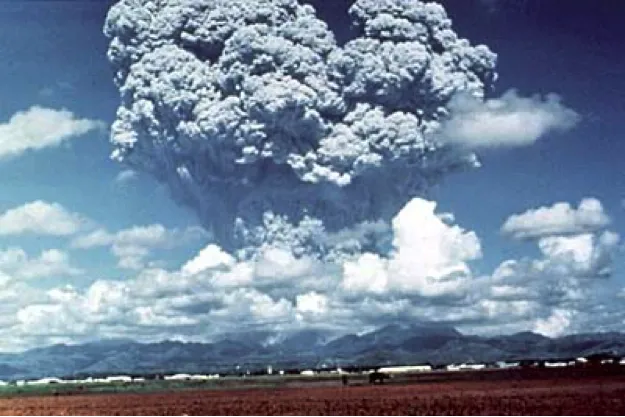How Volcanoes Influence Climate
Volcanic eruptions are responsible for releasing molten rock, or lava, from deep within the Earth, forming new rock on the Earth’s surface. But the largest and most explosive eruptions also impact the atmosphere.
The gases and dust particles thrown into the atmosphere during large volcanic eruptions can influence climate. Particles spewed from volcanoes, like dust and ash, can cause temporary cooling by shading incoming solar radiation if the particles were launched high enough into the atmosphere. The cooling effect can last for months to years depending on the eruption. But volcanoes can also cause climate to warm when eruptions spew greenhouse gases into the atmosphere. Over millions of years this caused global warming during times in Earth’s history when extreme amounts of volcanism emitted large amounts of greenhouse gases.

A huge cloud of volcanic ash and gas rises above Mount Pinatubo, Philippines, on June 12, 1991. Three days later, the volcano exploded in the second-largest volcanic eruption on Earth in the 20th century.
USGS
Even though volcanoes are in specific places on Earth, their effects can be more widely distributed as gases, dust, and ash get into the atmosphere. Because of atmospheric circulation patterns, eruptions in the tropics can have an effect on the climate in both hemispheres while eruptions at mid or high latitudes only have impact the hemisphere they are within.
Below is an overview of materials that make their way from volcanic eruptions into the atmosphere: particles of dust and ash, sulfur dioxide, and greenhouse gases like water vapor and carbon dioxide.
Particles of Dust and Ash
Volcanic ash or dust released into the atmosphere during an eruption shade sunlight and cause temporary cooling. Larger particles of ash have little effect because they fall out of the air quickly. Small ash particles form a dark cloud in the troposphere that shades and cools the area directly below. Most of these particles fall out of the atmosphere within rain a few hours or days after an eruption. But the smallest particles of dust get into the stratosphere and are able to travel vast distances, often worldwide. These tiny particles are so light that they can stay in the stratosphere for months, blocking sunlight and causing cooling over large areas of the Earth.
Sulfur from Volcanoes
Often, erupting volcanoes emit sulfur dioxide into the atmosphere. Sulfur dioxide is much more effective than ash particles at cooling the climate. The sulfur dioxide moves into the stratosphere and combines with water to form sulfuric acid aerosols. The sulfuric acid makes a haze of tiny droplets in the stratosphere that reflects incoming solar radiation, causing cooling of the Earth’s surface. The aerosols can stay in the stratosphere for up to three years, moved around by winds and causing significant cooling worldwide. Eventually, the droplets grow large enough to fall to Earth.
Greenhouse Gases Emitted by Volcanoes
Volcanoes also release large amounts of greenhouse gases such as water vapor and carbon dioxide. The amounts put into the atmosphere from a large eruption doesn't change the global amounts of these gases very much. However, there have been times during Earth history when intense volcanism has significantly increased the amount of carbon dioxide in the atmosphere and caused global warming.